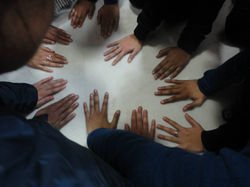About DMT
The Indian Association of Dance Movement Therapy (IADMT) defines DMT as "a psychotherapeutic method that uses movement and creative expression to further socio-emotional, cognitive, and somatic integration. This approach is based on the principle that the body and mind are integrated." It helps in self-expression to bring about a change in the total functioning of an individual. DMT is for individuals of all ages, gender, races, and ethnic backgrounds in individual, couples, family, and group therapy formats.
As an individual’s movement is seen as a form of communication, Dance Movement Therapists utilise this art form to help individuals or the group find a way to express their emotions and their experiences which helps in their own internal processes.
Dance Movement Therapy also provides a holistic and creative approach to healing and wellness. It asserts that the body and mind are interconnected wherein, changes in the body reflect changes in the mind and vice versa. DMT is primarily a sensory and kinaesthetic experience and recognises that all movements are unique. It is based on the presumption that:
-
Movement is universal and the first form of communication
-
Movements can be of various types, that is, functional, developmental, expressive, and communicative
-
Movement may be used as an assessment tool and/or as a primary mode of intervention
-
All movements have meaning and reflect the personality of the mover, and the creative process embodied in the use of free association in movement is inherently therapeutic
DMT-In-Action
Psst! Let's do a little digital/visual movement as you learn about Dance Movement Therapy. Click on or drag the images to rearrange, rotate, or zoom and interact with them.
 |  |  |  |  |
|---|---|---|---|---|
 |  |  |  |  |
DMT Professionals
The Indian Association of Dance Movement Therapy aims to be inclusive, culturally competent, and indigenously relevant. While taking into consideration the diversity of training programs available in the country and the need for various types and levels of DMT work, we recognise the following categories of DMT-related professionals in India:

Dance Movement Therapy Faciltiators (DMTF)
These are facilitators who have done certification programs taught by qualified DMTs or DMTPs. In order to continue being recognized as a DMTF, Continuous Professional Development (CPD) in the form of regular client work, self-work, supervision, attending workshops and conferences, etc. must be attended annually.

Dance Movement Therapists or Dance Movement Psychotherapists (DMT/DMP)
In order to become a DMT or DMP, a minimum qualification of a master’s level program is required. IADMT recognises that currently, there is no Indian master's program that meets these requirements. In order to continue being recognised as a DMT or DMP, the individual is expected to meet the CPD requirements in the form of regular client work, self-work, supervision, attending workshops and conferences, etc.

Dance Movement Therapy Practitioners (DMTP)
This role requires diploma-level training, taught by qualified DMTs. In order to continue being recognized as a DMTP, Continuous Professional Development (CPD) in the form of regular client work, self-work, supervision, attending workshops and conferences, etc. must be attended annually.

Dance Movement Therapy Reseracher (DMTR)
The Dance Movement Therapy Research category has been introduced to acknowledge and encourage the Research work being carried out by individuals specifically within the field of Dance Movement Therapy. More information to follow soon...
